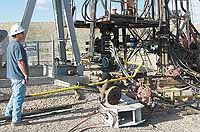| Johnny Downard, Conoco Phillips Completion supervisor inspects the workover operation. |
As 2004 progresses, Utah should continue to witness the state’s first steps toward economic recovery in the form of employment gains.
The movement toward job creation began in late 2003 and the momentum should continue through 2004, indicated Mark Knold, Utah Department of Workforce Services economist.
The momentum may not be as strong as the state would like, since productivity gains will still have a dampening effect on hiring.
In turn, the unemployment rate may not shrink rapidly. But employment growth should reach 1 percent to 1.5 percent.
In Utah, the rates are not adequate to absorb the internal population growth into the labor force or to generate adequate revenues to ease government budget concerns, explained Knold.
However, the statewide economic turnaround has to start at some point and business investment spending should rise throughout the remainder of 2004.
Product demand picked up in 2003, but worker productivity gains covered the increase. As the demand growth continues, productivity gains can carry only so far.
The Utah economy is ready to grow from not just productivity gains, but also by adding employees at companies operating at locations throughout the state, indicated the department of workforce services economist.
In addition, numerous businesses in the state will probably decide take advantage of accelerated depreciation and improving cash flows to update production technologies.
The situation should translate into more hiring activity and possibly more building projects statewide.
“We’ve seen, over the past year and a half, that the economy is capable of growing in dollar bill terms without adding jobs – even shedding jobs. Jobs though, are what’s needed to put people to work and to keep an economy vibrant, growing and generating adequate tax revenues,” commented Knold.
Residential construction made a significant contribution to the economic energy that surfaced across Utah in 2003. Residential construction will likely wane in 2004, but other sectors should pick up the spending slack, continued Knold.
Higher interest rates and the saturating of demand will combine to slow residential construction activity, but only modestly as long as mortgage interest rates hang in the 6.5 percent range.
Apartment and townhouse building have a chance of improving in 2004.
Non-residential construction activity will remain stressed, as commercial overbuilding could continue to be a hindrance for several years.
The Utah economy needs to experience employment growth of approximately 2.5 percent to provide adequate job opportunities to absorb the state’s internal labor force growth, pointed out the workforce services economist.
The expansion rate in question would require the addition of approximately 27,000 new jobs statewide.
Utah’s average yearly employment growth rate since 1960 registers at 3.4 percent.
“So it’s not a stretch for the economy to generate that many new jobs. But will the current environment create them? The odds are that it will not. Unfortunately, Utah probably won’t see that rate of growth until 2005,” concluded the department of workforce services economist.

